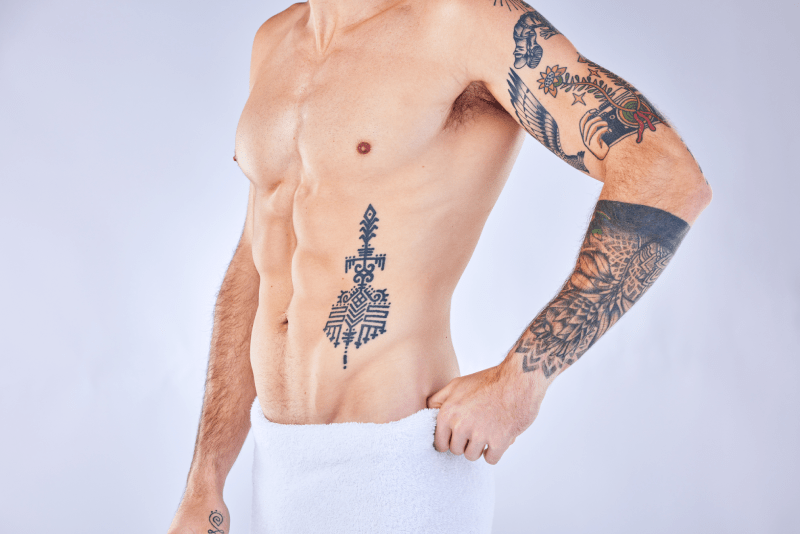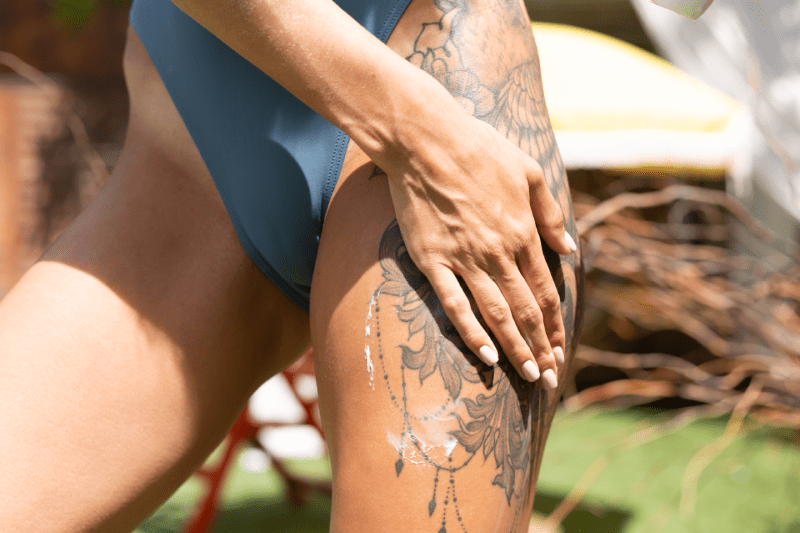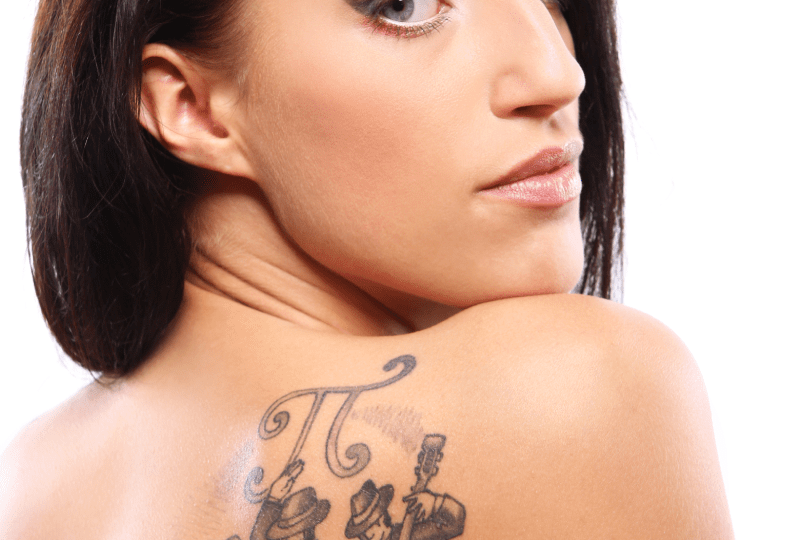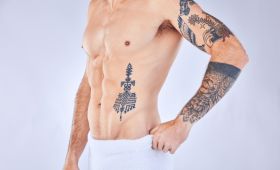When you realize that the tattoo you once loved no longer aligns with your life, the decision to remove it carries the excitement of starting fresh. However, the first question that usually comes to mind right after this decision is: Does the tattoo removal process hurt? This is absolutely a legitimate concern, and you might be surprised to learn how comfortable this process has become thanks to modern laser technologies.
In this comprehensive guide, we will examine step-by-step all the details of the laser tattoo removal process, ways to manage the pain, post-procedure recovery, and why you should choose the Cure Holiday experience in Turkey for this new journey.
Does Tattoo Removal Really Cause Pain?
Although the sensation of pain during tattoo removal varies from person to person, it is generally likened to the feeling of a “light rubber band snapping against the skin.” Most patients state that this pain is much shorter in duration than the pain felt when getting the tattoo. The laser creates short, sharp, and heating pulses as it targets and fragments the ink particles.
The intensity of the pain depends on the tattoo’s location on your body (areas near the bone are more sensitive), its size, and the person’s general pain threshold. Because modern Picosecond lasers operate much faster than older generation lasers, the total pain sensation has proportionally decreased due to the shortened exposure time.

Which Methods Are Used to Reduce the Sensation of Pain?
Clinics employ various methods to minimize the discomfort felt during the treatment. The most commonly used method involves applying powerful local anesthetic creams to the area before the procedure; these creams numb the surface of the skin, reducing the impact of the laser pulses. Additionally, specialized cooling devices are used to continuously cool the skin down to -30°C while the laser is being applied.
These devices protect the skin’s top layer and temporarily desensitize the nerve endings. In some cases, for very painful or large areas, local anesthetic injections may also be administered under doctor supervision. Thanks to these combined methods, the vast majority of patients are able to complete the procedure comfortably.
How is the Tattoo Removal Procedure Performed?
Laser tattoo removal is carried out using concentrated light energy. The laser device is configured by selecting a wavelength appropriate for the color of the tattoo ink. This light energy penetrates directly into the ink pigments without damaging the upper layers of the skin. After absorbing the laser’s energy, the ink particles rapidly turn into heat and break down into very small fragments. These shattered ink particles are recognized by the body’s natural immune system and are gradually eliminated from the body via the lymphatic system over time. Since more ink is fragmented with each session, the tattoo gradually fades and disappears.
Which Laser Technologies Are the Most Effective?
The most effective technologies for tattoo removal are Picosecond lasers, which emit pulses in trillionths of a second, and Q-Switched lasers, which emit pulses in millionths of a second (nanosecond). While Q-Switched lasers have been the standard for years, Picosecond lasers, thanks to their much shorter pulse duration, break down the ink using a photoacoustic (light-sound) effect instead of a thermal effect.
This results in less heat damage, faster healing, and much superior results, especially for stubborn colors like blue and green. The type of laser technology a clinic possesses is the most critical factor directly influencing the success and speed of the treatment.
What is a Picosecond (Pico) Laser? What is the Difference?
The Picosecond laser represents the latest innovation in tattoo removal technology. As its name suggests, it delivers energy to the skin in incredibly short pulses, in the range of a trillionth of a second. While traditional Q-Switched lasers heat and explode the ink particles, Pico lasers do this so rapidly that they create a photomechanical shockwave on the ink. This shockwave fragments the ink into much smaller particles, effectively turning it into dust. Consequently, the body clears these tiny particles more easily and quickly. This technology is considered the gold standard because it requires fewer sessions and reduces the risk of side effects.
How Many Sessions are Needed and What Should the Interval Be?
The number of sessions required varies greatly depending on the tattoo’s age, size, color, ink type, and depth. An average amateur tattoo may require 4 to 6 sessions, while professional, multi-colored, and densely inked tattoos may require 8 to 12 sessions or even more.
The ideal interval between sessions is the time needed for the skin to heal and for the body to clear the fragmented ink; this period is typically 6 to 8 weeks. Strict adherence to this interval is crucial for avoiding skin damage and achieving the best results. Patience is the key to a successful tattoo removal process.
How Do Tattoo Color and Size Affect the Removal Process?
The color of the tattoo determines the wavelength at which the laser will operate, significantly impacting the removal process. Black ink is the easiest color to remove because it absorbs all laser wavelengths. Dark blue, purple, and red colors also generally respond well. However, light and bright colors like green and light blue are the most stubborn, and advanced devices like Pico lasers and different wavelengths are often required for these colors. While the size of the tattoo directly affects the session duration and total cost, it is not a determining factor in removal success.
Can All Colors Be Removed at the Same Rate?
Unfortunately, not all tattoo colors can be removed at the same speed and rate. Tattoo removal is based on the principle of laser light being absorbed by ink pigments; each color reacts to a different wavelength on the spectrum. Black ink is the fastest color to disappear, while colors like green and turquoise are the hardest to remove because they tend to reflect laser light. To remove these difficult colors, clinics often have to target the pigments using different wavelengths of Pico lasers, such as 532 nm, 755 nm, or 1064 nm. Therefore, multi-colored tattoos require a longer and more complex treatment plan than single-colored tattoos.
What Are the Side Effects of the Tattoo Removal Procedure?
Temporary side effects after laser tattoo removal are common and are a normal part of the healing process. The most common ones are redness, swelling, and slight blistering in the treated area. These blisters usually heal on their own within a few days and must never be popped. Additionally, temporary darkening (hyperpigmentation) or lightening (hypopigmentation) of the skin color may be observed in the area. These color changes usually resolve over time, but can sometimes be permanent, especially if sun protection is neglected. The risk of permanent scarring is low, but this risk can increase when performed by an incompetent practitioner.

How Should Skin Care Be Managed After Tattoo Removal?
Strict adherence to post-procedure care instructions is essential for successful tattoo removal and rapid healing. You are usually asked to keep the dressing applied immediately after the procedure for 24 hours. After that, you must regularly use the antibiotic ointment or special wound care creams recommended by your clinic, usually for 7 to 10 days. The most critical rule is to absolutely protect the treated area from the sun; this means using high-factor (SPF 50+) sunscreen and covering it with clothing. Furthermore, avoiding rubbing or scratching the area, even if it is itchy, is important to prevent scarring.
How Long Does the Recovery Process Take?
After each laser session, a period of 6 to 8 weeks is generally required for the skin to fully heal and be ready for the next session. However, the first acute recovery period after the session is shorter. Swelling and redness peak in the first 24 hours, and these symptoms decrease within the first 3-7 days. Blisters and scabs that form fall off within approximately 1-2 weeks. This two-month interval is needed for complete recovery because it allows time for your immune system to slowly clear the fragmented ink. Attempting to shorten the duration can cause permanent damage to the skin.
Does Any Trace Remain of the Old Tattoo?
While laser tattoo removal technologies are highly advanced, complete disappearance of the tattoo without leaving a trace cannot be guaranteed. The success rate largely depends on factors such as the tattoo’s age, type, and ink density. A very slight “shadow” might always remain after professional, multi-layered tattoos. However, when experienced specialists and the latest Pico laser devices are used, the remaining trace is usually a subtle hypopigmentation (lightening of the skin color) that is difficult to notice. The real risk of scarring comes from burns and scars resulting from neglecting post-procedure care or using poor-quality devices.
Does the Removal Procedure Cause Permanent Damage to the Skin?
When performed with the correct devices and by trained specialists, the risk of the tattoo removal procedure leaving permanent damage on the skin is quite low. The laser’s purpose is only to target the ink pigments and to protect the surrounding skin tissue as much as possible. Permanent damage (scarring or thinning of the tissue) usually results from two main causes: 1) Incorrect laser settings or insufficient cooling, which leads to thermal burns. 2) The patient’s failure to adhere to post-procedure care instructions, particularly picking at scabs or sun exposure. Choosing an accredited and experienced clinic is vital to minimize these risks.
On What Factors Does the Removal Cost Depend?
The cost of the tattoo removal procedure depends on a number of variables. The most determining factor is the size of the tattoo; pricing is usually done per square centimeter or based on the area covered by the tattoo. The second important factor is the number of sessions required; stubborn, multi-colored tattoos require more sessions, increasing the cost. Additionally, the type of laser technology used also affects the price; Pico lasers, being higher-tech, may be more expensive per session than Q-Switched lasers. The geographical region (country or city) of the clinic and the level of the clinic’s expertise also play a significant role in pricing.
Can a New Tattoo Be Done Over the Removed Area?
Yes, a new tattoo can be done over the same area after the removal process is complete. In fact, many people opt for removal not to erase the tattoo completely, but to prepare the ground for a new “Cover-Up” tattoo. For the new tattoo to be successful, the ink of the old tattoo must be significantly faded (at least 70-80%). This allows the new tattoo artist greater creative freedom without having to work with darker and more complex ink colors. It is recommended to wait at least 6 months for the skin to fully heal before getting a new tattoo.
Are Amateur Tattoos Easier to Remove Than Professional Tattoos?
Generally, yes, amateur tattoos are easier and require fewer sessions to remove than professional tattoos. Amateur tattoos usually result from the ink being closer to the surface of the skin and less dense. Professional tattoos, however, deposit the ink much more densely and evenly into the deeper layers of the skin, the dermis. Furthermore, the quality of ink and the color palette used in professional tattoos are wider, making the removal of some difficult colors (bright blue, green) harder. Therefore, amateur tattoos can often require half the number of sessions compared to professional tattoos.
Who Cannot Benefit from the Tattoo Removal Procedure?
The tattoo removal procedure may not be suitable for everyone, and some medical conditions temporarily or permanently prohibit this treatment. Individuals with active skin infections, those prone to keloid (excessive scar) formation, and pregnant or breastfeeding women should generally avoid this procedure. Also, careful evaluation is required for patients using immunosuppressive or blood-thinning medications. Skin diseases (vitiligo, psoriasis) or dark skin types need careful evaluation with the approval of a specialist doctor, as they can increase the risk of pigmentation changes and side effects. It is important to share your entire medical history in detail during the initial consultation.
What Should Be Considered Before the Procedure?
There are several important rules to consider before the tattoo removal procedure. The area to be treated must not have been exposed to direct sunlight for at least 4 weeks, otherwise, the laser may cause burns on the skin. Before coming for treatment, you should gently clean the area and avoid applying any makeup, perfume, or lotion. Blood-thinning medications (like aspirin) or certain vitamins and supplements should be stopped a few days before the procedure upon doctor’s advice, as they can increase the risk of bruising. Additionally, drinking plenty of water before the session can help the healing process by increasing skin hydration.
Why Should Turkey Be Preferred for Tattoo Removal?
Turkey has become a globally recognized center for aesthetic and medical procedures like tattoo removal. This preference is based on high-standard health services, technological equipment, and economic advantages. Turkish clinics adhere to international standards in using the latest laser devices, including state-of-the-art Pico laser systems. Moreover, specialists in Turkey have extensive experience in this field and offer high success rates even in complex tattoo removal cases. All these medical superiorities, combined with attractive prices, make Turkey an ideal destination for international patients.
Laser Technology and Expertise Level in Turkey
Modern clinics in Turkey rapidly invest in the latest laser technologies worldwide. Pico-second lasers, the gold standard in tattoo removal, are widely used in the country’s leading aesthetic centers. This means patients can access the same high technology available in Europe or America, but at much more affordable costs. Furthermore, Turkish dermatologists and aesthetic surgeons receive international training and are highly specialized in managing complex skin reactions. With its expert staff, Turkey prioritizes not only quality but also safety in treatment.

Price Advantages Compared to Europe and America
One of Turkey’s greatest attractions in tattoo removal services is its cost-effectiveness. Despite offering the same level of technology and expertise, the cost per session in Turkey can be 50% to 70% lower than prices in Europe, the United Kingdom, or the United States. This price advantage stems from lower overall operating and labor costs. For a comprehensive tattoo removal project requiring multiple sessions, this cost difference can translate into savings large enough to cover travel, accommodation, and even holiday expenses.
The Rise of Medical Tourism in Turkey
Turkey has recently risen as a global superpower in the field of health tourism. It hosts thousands of international patients in areas such as tattoo removal, hair transplantation, aesthetic operations, and dental treatments. Thanks to intense incentives and investments by the government and the private sector in health tourism, the clinical infrastructure and patient services are constantly improving. Clinics with international accreditations implement all necessary protocols to ensure patients feel secure. This rise is a testament to the reliability and quality of treatments in Turkey.
Combining the Treatment Process with a Holiday Experience
Since the tattoo removal process often requires long intervals between sessions, Turkey offers the opportunity to turn these intervals into a perfect holiday opportunity. When you come to Turkey for each session, you are not only receiving treatment but also getting the chance to explore the historical richness of Istanbul, the sunny beaches of Antalya, or the unique geography of Cappadocia. This “treat and travel” concept reduces the stress of the removal process and offers you a chance to pamper yourself and rejuvenate. By the time your treatment finishes, you will also have wonderful holiday memories.
Tattoo Removal Opportunities in Istanbul
Istanbul is considered the heart of medical tourism in Turkey and boasts the widest and most advanced range of clinic options for tattoo removal. Many aesthetic centers and dermatology clinics with Pico laser technology, operating at international standards, are located on both sides of the city. Clinics in Istanbul often employ multilingual staff and offer luxurious services that cater to patients’ needs, from treatment planning to accommodation. Istanbul’s central location also provides easy and direct flight access from all over the world.
The Role of Antalya in Health Tourism
Antalya, the pearl of the Mediterranean, is a popular alternative, especially during the summer months, for patients who want to combine tattoo removal sessions with a beach holiday. Clinics in Antalya, being close to the tourist area, allow patients to relax comfortably and enjoy their holidays outside of treatment hours. High-quality medical aesthetic centers offer not only removal services but also additional treatments like skin rejuvenation and sun damage repair, creating a holistic skin care opportunity.
What Standards Do Clinics in Turkey Adhere To?
Leading medical aesthetic clinics in Turkey are generally subject to international health standards (e.g., JCI – Joint Commission International) or the strict audits of the Turkish Ministry of Health. These accreditations guarantee that the hygiene, device quality, staff training, and patient safety protocols in the clinics are at the highest level. Treatment plans are customized taking into account the patient’s general health status and skin type. These strict standards ensure patients are satisfied with the treatment results and that the risk of any complications is kept to a minimum.
Visa Procedures in Turkey Before Starting Treatment
Turkey does not require a visa for short-term tourist visits for citizens of many countries or offers visa-on-arrival convenience. Although tattoo removal sessions are brief, given the necessary session intervals, it is important for patients to check current visa requirements to ensure they do not face issues with entry, exit, or stay permits throughout their treatment process. In most cases, a standard tourist visa will suffice, but it is best to get information from the relevant embassies for those planning long stays or frequent visits.
Accommodation and Transportation Facilities in Turkey
Accommodation and transportation services specifically designed for medical tourism patients are highly developed in Turkey. Clinics in major cities often include airport and hotel transfer services in their packages. Accommodation options range from budget-friendly boutique hotels to luxurious hospital hotels that offer maximum comfort during the recovery period. This ease of organization aims to allow international patients to focus on the treatment and eliminate the logistical stress associated with travel.
Tourist Destinations to Explore Between Tattoo Removal Sessions
The 6-8 week waiting period between sessions offers a wonderful opportunity for patients to explore Turkey’s cultural and natural beauties. After resting for the first few days after the session, patients can visit the historical texture of the ancient city of Ephesus, the white travertines of Pamukkale, or the lush green plateaus of the Black Sea, for example. Planning different trips throughout the treatment process helps turn this long and patient-requiring journey into a much more enjoyable and unforgettable experience.
Availability of English-Speaking Healthcare Staff in Turkey
In all major clinics and medical tourism agencies serving international patients, multilingual staff and translators are available to ensure patients feel comfortable, speaking English (and often other languages like German or Arabic). Doctors, nurses, and patient coordinators can explain the treatment process and care instructions in the patient’s native language or a common language. This language support eliminates misunderstandings and ensures the patient continues the treatment with confidence.
Having Post-Treatment Check-ups Done in Turkey
The success of the tattoo removal procedure depends not only on the quality of the laser application but also on regular check-ups. Patients treated in Turkey usually remain in contact with the clinic between each session and combine subsequent check-ups with the next session. This system allows doctors to closely monitor the skin’s reaction to the ink and quickly optimize laser settings if necessary. Some clinics even provide remote consultation services after the patient returns to their country, ensuring continuous support.
Specialized Clinics in Turkey According to Different Tattoo Types
Thanks to the size of the aesthetic market in Turkey, it is possible to find clinics specialized in different types of tattoos. For example, some centers specialize only in the removal of cosmetic (permanent makeup) tattoos, while others have advanced expertise in treating large, professional, multi-colored tattoos or traumatic tattoos. Intermediary agencies like Cure Holiday provide guidance in selecting the most suitable, competent, and well-equipped clinic for the patient’s specific tattoo type and skin condition, guaranteeing the best outcome.

What is Cure Holiday and What Does It Offer?
Cure Holiday is a full-service health tourism agency that enables international patients to receive high-quality medical and aesthetic treatments in Turkey. For tattoo removal, it offers packages that are organized from start to finish, tailored to the patient’s needs and budget. Cure Holiday’s core philosophy is to combine the treatment process with a comfortable, stress-free, and luxurious holiday experience without compromising on medical quality. Its expert staff not only directs patients to treatment but also handles all travel and accommodation arrangements.
Cure Holiday’s Comprehensive Holiday and Treatment Packages
Cure Holiday offers all-inclusive packages specially designed for tattoo removal patients. These packages typically cover the cost of treatment sessions, accommodation in select hotels, VIP transfer services between the airport and the clinic, and initial consultation fees. With this holistic approach, patients do not have to deal with any logistical details other than the treatment once they arrive in Turkey. The packages can be flexibly adapted according to the patient’s tattoo removal requirements and desired holiday duration.
Steps of Treatment with Cure Holiday: From First Contact to the Last Session
The tattoo removal journey with Cure Holiday begins with a few simple steps. First, the patient shares photos of their current tattoo and their medical history. Based on this information, Cure Holiday specialists receive a preliminary assessment from contracted expert doctors and offer a personalized treatment plan and cost quote. Once the patient’s approval is received, travel dates are determined, and accommodation and transfers are organized. Upon arrival in Turkey, the patient is welcomed with VIP transfers and supported by a coordinator at every step of the treatment process.
Holistic Approach: Treatment, Accommodation, and Transfers
The services offered by Cure Holiday are not limited to the treatment in the laser room; they cover the patient’s entire experience. The hotels where patients stay are conveniently located near the clinic and adhere to high comfort standards. Luxury transfer vehicles ensure that patients, who may be tired and sensitive, can travel comfortably between clinics. Furthermore, the planning of the treatment, session intervals, and rest days are meticulously coordinated, thereby guaranteeing that the patient gets the highest efficiency from the treatment while also enjoying their holiday.
What is Included in the Treatment Cost? Transparency Guarantee
Cure Holiday adopts a principle of full transparency regarding costs. The package prices it offers usually cover the cost of laser sessions, materials used, doctor’s fees, accommodation (for the specified duration), airport transfers, and local transportation. There are no hidden or unexpected extra charges. Patients know exactly what they are paying for before starting treatment, which makes budget planning extremely easy for international patients and builds trust.
Expert Clinics Contracted by Cure Holiday
Cure Holiday collaborates only with clinics that adhere to the highest international standards, use the latest technologies like Pico laser, and have proven expertise in their field. These clinics are centers supervised by the Turkish Ministry of Health and managed by experienced dermatology specialists. This rigorous selection process is Cure Holiday’s quality guarantee to ensure patients receive not only affordable but also reliable and successful treatment.
Creating a Personalized Treatment Plan
Every tattoo and every skin type is unique. Cure Holiday puts this individuality at the center from the patient’s first consultation. Initial photos and medical history are reviewed by contracted doctors to determine a personalized estimated number of sessions and laser protocol based on the tattoo’s age, ink type, and skin sensitivity. This personalized approach guarantees that the patient does not waste time and money and achieves the best possible removal result.
A Safe and Stress-Free Experience with Cure Holiday
Undergoing medical treatment abroad can be stressful, but Cure Holiday aims to completely eliminate this stress. All travel logistics, appointments, and language barrier issues are managed by Cure Holiday. Patient coordinators stand by the patient from arrival in Turkey until departure. This support offers a completely safe and stress-free experience, where the patient’s only task is to focus on the treatment and enjoy the beauty of Turkey.
Take the First Step: Free Consultation and Information
You now know that the pain of tattoo removal is manageable and that Turkey offers an excellent option for this process. If you are ready to say goodbye to your old tattoo and turn this process into an enjoyable holiday experience, take the first step. Cure Holiday offers a completely free and non-binding consultation service for the treatment plan and cost quote that will be prepared specifically for you. Reach out to Cure Holiday experts today to achieve the new beginning of your dreams in Turkey and do yourself a favor.

